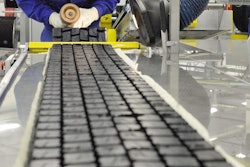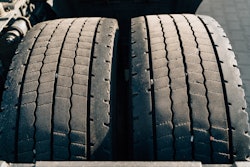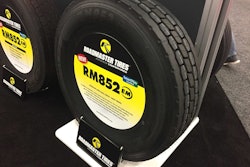The following was published in CCJ's Equipment Maintenance Toolkit, 8th edition, sponsored by Valvoline Heavy Duty. CCJ's Equipment Maintenance Toolkit is a complementary industry resource, courtesy of our partnership with Valvoline Heavy Duty. You can download the entire Toolkit here.
Tire selection is often focused on brand name and application, but tread pattern can have just as much impact on the tire’s lifecycle.
The more rubber you have making contact to the road, typically the better the tire is going to perform and you’ll get longer wear out of it that way, according to Cooper Tire & Rubber Company. There’s a lot of engineering that goes into a tire. Not just the construction but the compounding, especially the tread compounding with rolling resistance.
Bill Walmsley, product marketing manager for Michelin Americas Truck Tires, says tire compounds, casing design and tread sculpture all work synergistically toward achieving performance gains.
“Not only are tires selected by position to maximize performance of the vehicle but compounding, casing and tire architecture contribute significantly to wear, fuel and weight savings,” he says.
Goodyear says a tire’s tread pattern, like its compounding and other construction elements, is determined by the routes and equipment that fleets run. For example, fuel economy and long wear are ongoing concerns for many long-haul fleets, so long-haul tire tread patterns tend to be stiffer in order to promote the fuel efficiency.
Tire tread patterns for regional haul carriers, according to Greg Kidd, Sales Engineering Manager for Bridgestone Americas Tire Operations, are similar to long haul in that they place a high emphasis on tread mileage and irregular wear.
“Regional trucks also are concerned with fuel economy, but it is not as great of a need as it is with the line haul application due to increased stop and go,” he says.
In vocations like mixed service, where miles to removal and traction are more important, tread patterns will be deeper and more open for enhanced on/off-road grip.
"The first step is to determine what your goals are for your tire program,” adds Walmsley. “For over-the-road operations, it is a common goal to maximize fuel savings. For more localized operations, the goals may be more focused on lowering the cost per mile. Additional goals may be to maximize the overall life of the tire as an asset, which looks at the value of the casing for retreadability. Once you have an idea of your overall goals, it makes selecting the right tire a smoother process as it guides you through it.”
Wheel position will also dictate tread patterns. Since trailer tires are free rolling and subject to less scrub from turning, they tend to have more shallow, rib-like designs.
Steer tires tend to be more rib-like in order to promote longer miles to removal and resistance to irregular wear, Goodyear says. Drive tire tread designs tend to be deeper and more open in order to provide more traction. Tread rubber compounding and tread design can enhance performance in specific applications when designed together.
Limitations in a tire’s tread pattern can be made up for in its tread compound, and vice versa. For instance, if a tire’s tread compound cannot deliver required wet stopping distance performance, its tread pattern can be optimized to improve the way that water is evacuated from the tread area.
Tread patterns can have a significant impact on tire life, and selecting a tire with the wrong tread pattern for its application can lead to premature wear and other problems. Misapplications can result in reduced performance and premature wear.
“Selecting incorrect tires for applications negates the intended design and purpose of the tire itself,” adds Kidd.
Equipment also plays a role in determining the tire, Walmsley says.
If a truck is a 6X4 application, for example, the tire selection may be different than a 4X2 or 6X2 application due to the amount of torque being applied.
“Tire manufacturers may use different tread depths, compounds and tire design features depending on the targeted applications,” he says. “Tire manufacturers normally indicate on their website which tires are best suited for the various applications.”











